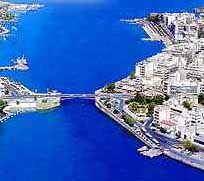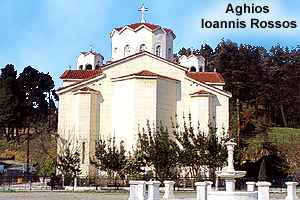|
Evia
 The island Evia is the
second largest in Greece after Crete, has played an important
role in Greek History from earliest prehistory to the present
day. Its importance is chiefly due to its geographical
position and geomorphology. It is 175 kilometers long and
faces the Greek mainland along the whole length of its eastern
seaboard. A main highway and ferryboats from several terminals
connect this island, of great natural beauty and scenic
variety, to the mainland. Evia is brisk with tourist traffic,
but there are still many peaceful and unspoilt villages. There
are large fertile valleys, sandy beaches, organised bathing
facilities, secluded coves and wooded mountainsides, ideal for
climbing.
The island Evia is the
second largest in Greece after Crete, has played an important
role in Greek History from earliest prehistory to the present
day. Its importance is chiefly due to its geographical
position and geomorphology. It is 175 kilometers long and
faces the Greek mainland along the whole length of its eastern
seaboard. A main highway and ferryboats from several terminals
connect this island, of great natural beauty and scenic
variety, to the mainland. Evia is brisk with tourist traffic,
but there are still many peaceful and unspoilt villages. There
are large fertile valleys, sandy beaches, organised bathing
facilities, secluded coves and wooded mountainsides, ideal for
climbing.
History of
Karystos: Karystos
has known great glory at different times, from the prehistoric
period. It took its name, from the son of the
historic-mythical Centaur Heron, the heroic Karystos, who was
the ruler of this place and gave it its name.
According to mythology, the romance between the two greatest
gods of ancient Greece, Zeus and Hera, was created on the top
of mountain Ochi (1389m) above Karystos. In the ancient times,
Karystos developed the trade, shipping and science, art and
sports as well. The famous athlete Glaukos who was a winner at
the Olympic Games of 520 B.C. at boxing was a Karystian.
Famous are the Karystian marbles (Marmor Karystium) known as
Cipollino and the Pillars that were made of them are still
decorating ancient monuments in Athens, Rome, Instambul and
other places. Many people came through Karystos: Persians,
Romans, Venetians, Franks, Turks, and the monuments that have
been saved can give evidence of their crossing.
 Sightseeing's:
Each
place of South Evia offers different interests. In distance of
3-4 kilometers from Karystos there are picturesque villages
into all green slopes and ravines on foot of Ochi mountain.
These villages are Kalivia, Lala, Aetos, Mili, Paleochora,
Grambias, Mekounida, Nikasi, villages with plentiful waters,
many trees, beautiful gardens, old lord's houses and excellent
view. The Castle of Western Europe, "Castello
Rosso", built in the 13th century, the most powerful of
its period. The charming place of Agia Triada, a valley with
two small churches under enormous plane-trees and a plentiful
clear waters. 100 meters northeastern from the country chapels
there is a sensational cave. Byzantine church of Agion
Taxiarchon in Kalivia. Sightseeing's:
Each
place of South Evia offers different interests. In distance of
3-4 kilometers from Karystos there are picturesque villages
into all green slopes and ravines on foot of Ochi mountain.
These villages are Kalivia, Lala, Aetos, Mili, Paleochora,
Grambias, Mekounida, Nikasi, villages with plentiful waters,
many trees, beautiful gardens, old lord's houses and excellent
view. The Castle of Western Europe, "Castello
Rosso", built in the 13th century, the most powerful of
its period. The charming place of Agia Triada, a valley with
two small churches under enormous plane-trees and a plentiful
clear waters. 100 meters northeastern from the country chapels
there is a sensational cave. Byzantine church of Agion
Taxiarchon in Kalivia.
If you attempt to go up to Ochi mountain you will see:
At the position of Kylindroi, north of Mili village on
altimeter of 600 meters, an ancient quarry with 8 big pillars.
Mountain shelter on altimeter of about 1200 meters and
southeastern of the shelter a big chestnut forest.
"Drakospito" an ancient structure with enormous flat
stones on the top of Ochi mountain. |